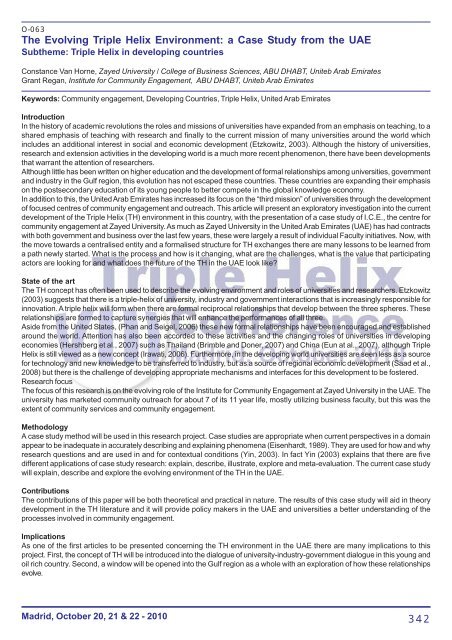TRIPLE HELIX noms.pmd
TRIPLE HELIX noms.pmd
TRIPLE HELIX noms.pmd
You also want an ePaper? Increase the reach of your titles
YUMPU automatically turns print PDFs into web optimized ePapers that Google loves.
O-063The Evolving Triple Helix Environment: a Case Study from the UAESubtheme: Triple Helix in developing countriesConstance Van Horne, Zayed University / College of Business Sciences, ABU DHABT, Uniteb Arab EmiratesGrant Regan, Institute for Community Engagement, ABU DHABT, Uniteb Arab EmiratesKeywords: Community engagement, Developing Countries, Triple Helix, United Arab EmiratesIntroductionIn the history of academic revolutions the roles and missions of universities have expanded from an emphasis on teaching, to ashared emphasis of teaching with research and finally to the current mission of many universities around the world whichincludes an additional interest in social and economic development (Etzkowitz, 2003). Although the history of universities,research and extension activities in the developing world is a much more recent phenomenon, there have been developmentsthat warrant the attention of researchers.Although little has been written on higher education and the development of formal relationships among universities, governmentand industry in the Gulf region, this evolution has not escaped these countries. These countries are expanding their emphasison the postsecondary education of its young people to better compete in the global knowledge economy.In addition to this, the United Arab Emirates has increased its focus on the “third mission” of universities through the developmentof focused centres of community engagement and outreach. This article will present an exploratory investigation into the currentdevelopment of the Triple Helix (TH) environment in this country, with the presentation of a case study of I.C.E., the centre forcommunity engagement at Zayed University. As much as Zayed University in the United Arab Emirates (UAE) has had contractswith both government and business over the last few years, these were largely a result of individual Faculty initiatives. Now, withthe move towards a centralised entity and a formalised structure for TH exchanges there are many lessons to be learned froma path newly started. What is the process and how is it changing, what are the challenges, what is the value that participatingactors are looking for and what does the future of the TH in the UAE look like?State of the artThe TH concept has often been used to describe the evolving environment and roles of universities and researchers. Etzkowitz(2003) suggests that there is a triple-helix of university, industry and government interactions that is increasingly responsible forinnovation. A triple helix will form when there are formal reciprocal relationships that develop between the three spheres. Theserelationships are formed to capture synergies that will enhance the performances of all three.Aside from the United States, (Phan and Seigel, 2006) these new formal relationships have been encouraged and establishedaround the world. Attention has also been accorded to these activities and the changing roles of universities in developingeconomies (Hershberg et al., 2007) such as Thailand (Brimble and Doner, 2007) and China (Eun at al., 2007), although TripleHelix is still viewed as a new concept (Irawati, 2006). Furthermore, in the developing world universities are seen less as a sourcefor technology and new knowledge to be transferred to industry, but as a source of regional economic development (Saad et al.,2008) but there is the challenge of developing appropriate mechanisms and interfaces for this development to be fostered.Research focusThe focus of this research is on the evolving role of the Institute for Community Engagement at Zayed University in the UAE. Theuniversity has marketed community outreach for about 7 of its 11 year life, mostly utilizing business faculty, but this was theextent of community services and community engagement.MethodologyA case study method will be used in this research project. Case studies are appropriate when current perspectives in a domainappear to be inadequate in accurately describing and explaining phenomena (Eisenhardt, 1989). They are used for how and whyresearch questions and are used in and for contextual conditions (Yin, 2003). In fact Yin (2003) explains that there are fivedifferent applications of case study research: explain, describe, illustrate, explore and meta-evaluation. The current case studywill explain, describe and explore the evolving environment of the TH in the UAE.ContributionsThe contributions of this paper will be both theoretical and practical in nature. The results of this case study will aid in theorydevelopment in the TH literature and it will provide policy makers in the UAE and universities a better understanding of theprocesses involved in community engagement.ImplicationsAs one of the first articles to be presented concerning the TH environment in the UAE there are many implications to thisproject. First, the concept of TH will be introduced into the dialogue of university-industry-government dialogue in this young andoil rich country. Second, a window will be opened into the Gulf region as a whole with an exploration of how these relationshipsevolve.Madrid, October 20, 21 & 22 - 2010342










